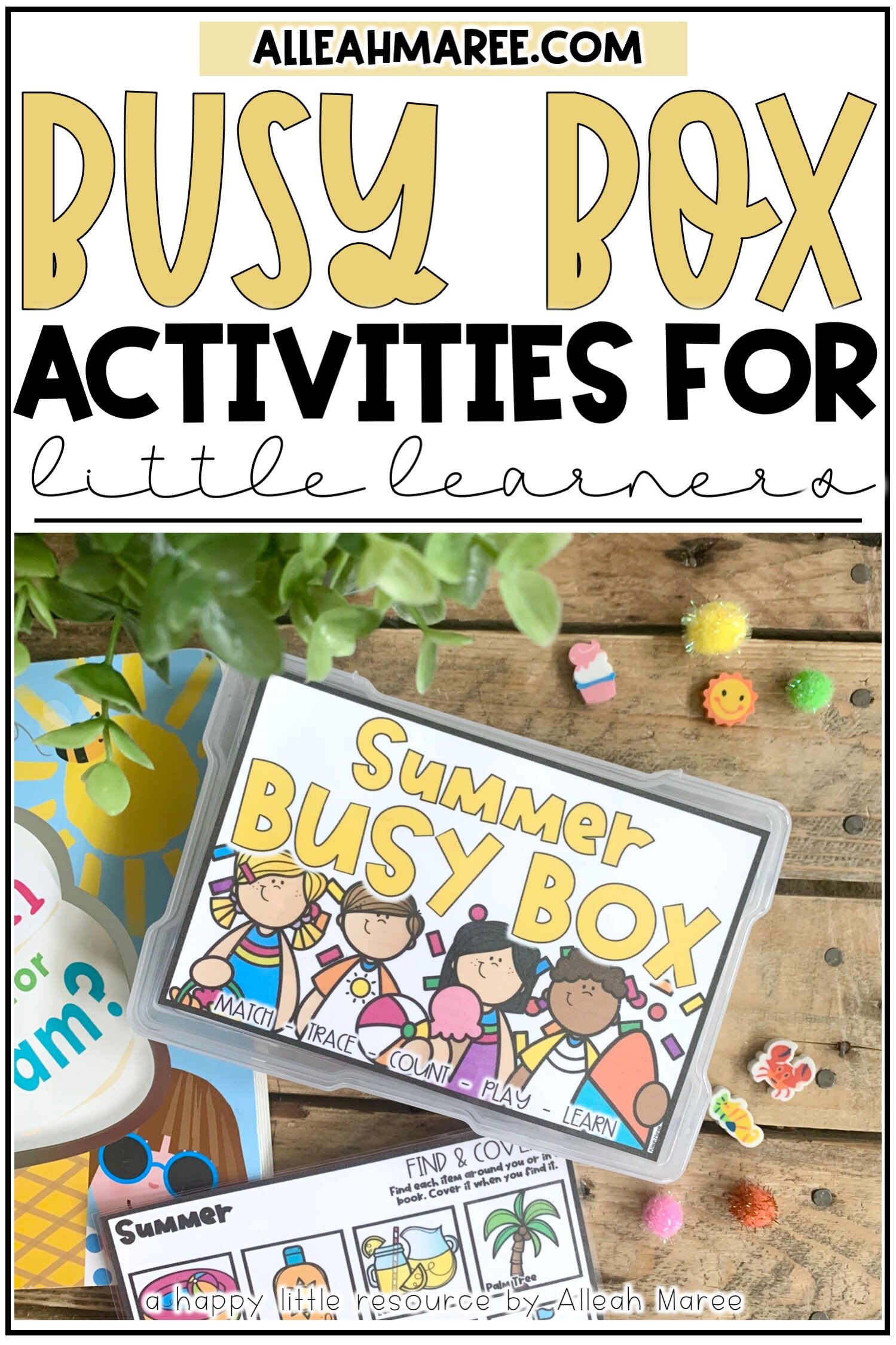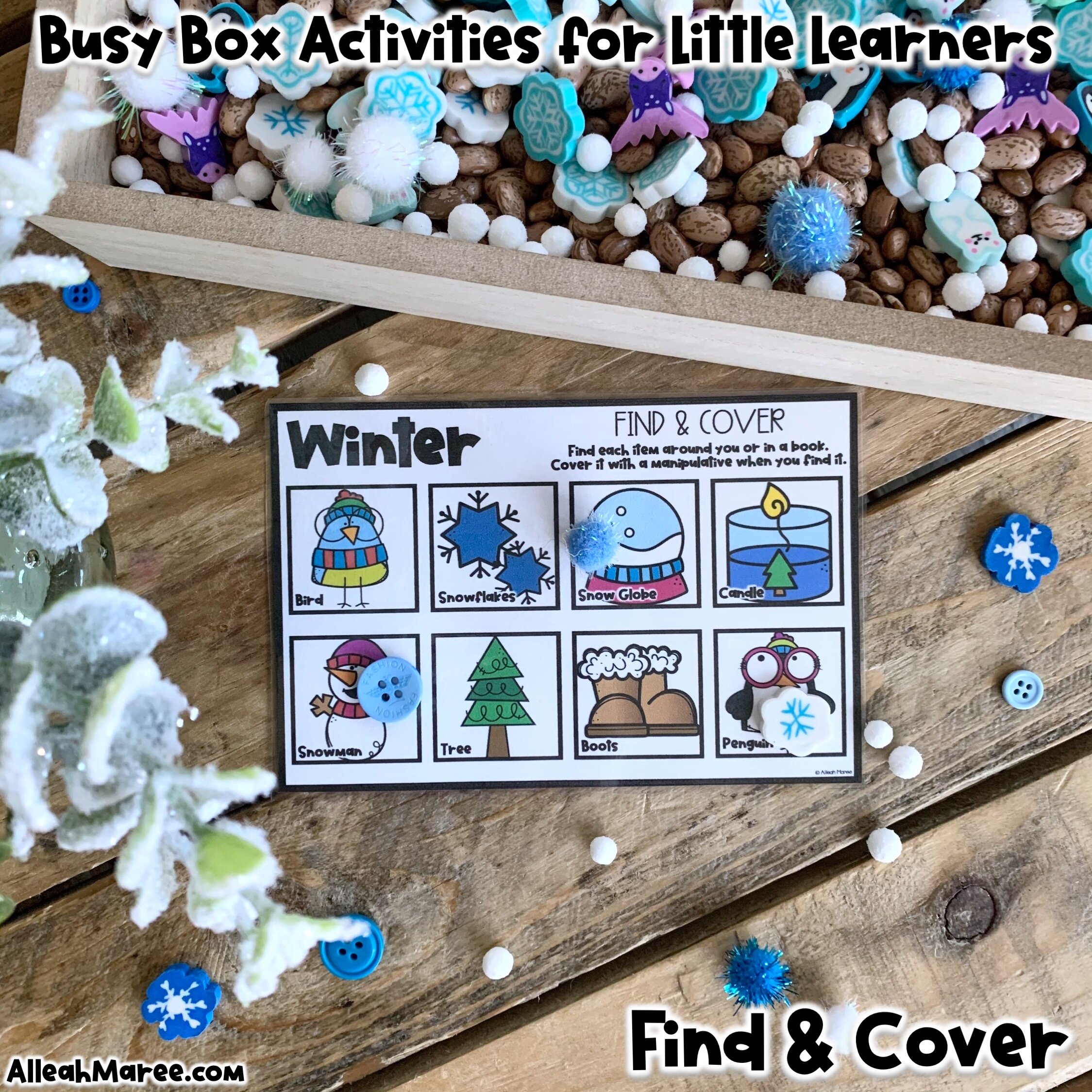Busy Box Activities for Little Learners
If you have little ones who love to learn but you don’t love tiny pieces of activities strewn around the house, Busy Boxes are for you! Busy Boxes are activities for toddlers and preschoolers that all fit into 4x6 photo boxes. You can toss in dry erase markers, crayons, mini erasers, or any other small manipulatives that your kids may need into the box and they’re ready to start learning. Scroll down to check out all the activities included in these nifty, little play-and-learn resources!
PSSSSSSTTTTTTT! There’s also a free sample linked at the end of the post. Be sure to grab it to try!
The matching activities included are perfect for practicing matching visual discrimination, which deals with noticing pictures that are the same and noticing parts that are different. The matching activities included in these busy boxes are simple ways to practice matching, as well as introduce new vocabulary words. Some words may be familiar to your little ones, but some may be brand new! You can help those new words stick by connecting the words you’ve read in a book with the words they’re learning in their busy box. Making connections is a great way to help learners anchor their learning and retain that new knowledge.
Tracing is a great way for little ones to start learning how to control their hand movements. These fine motor skills take a lot of muscle control and practice, so using these skills in a variety of ways is a great way to help your little one develop these skills more quickly. These busy boxes includes pages to practice tracing letters, numbers, and a variety of lines. Your little one can use a dry erase marker to trace, cover the lines’ curves with a small manipulative like mini erasers, or use play dough or wikki sticks or pipe cleaners to create the shapes and lines. And if your little ones isn’t ready for a marker or manipulative, just encourage them to practice tracing using their fingers!
The shapes activities included in busy boxes are great for practicing matching and naming shapes. Your little ones can practice describing the shapes to expand and practice their math vocabulary. You can help those new words stick by connecting the words you’ve read in a book with the words they’re learning in their activity. Can they build the shapes with manipulatives after matching them? Do they want to draw or trace the shapes? Want to create them out of playdough or find a shapes video to sing along to? You can extend the learning from this activity in a VARIETY of fun ways!
Practicing letter names and shapes is a super important, foundational literacy skill for young learners. The letter activities included in busy boxes are super hands-on and work super well for practicing matching and naming capital letters. Your little ones can practice matching the letter cards to the letter mats or tracing the letters with a dry erase markers. When they’re done with these activities, you can extend the learning by creating the letters with manipulatives or playdough, matching magnetic letters to the mat too, or singing along to a letters video or song. Immersion is a great way to soak up lots of information about a topic, so toss them into those letters any way you want to!
Learning letter names and letter sounds is an essential literacy skill for little ones. So, even if they’re not quite ready for letter names and sounds independently, this activity is a fun one to do together. You can hide the letter cards around the room or place them in a sensory bin and have your kiddo choose a card. Then, talk together about what the picture is, what letter the word starts with, and where they see that matching letter on the page of their busy book. I’d recommend telling them the most common sound the letter makes and see if they can copy that sound too! This activity will probably be a VERY guided learning time at the beginning, but as kiddos start to recognize the way letters look and remember the sounds from hearing them often or singing phonics songs, this sort of activity will get easier.
Need a few other ways to practice the alphabet? Check out this blog post about fun ways to learn the alphabet!
The activities included for practicing counting and number identification serve a few purposes. Of course, learning one-to-one correspondence and counting objects is an obvious one, but this activity also is great for practicing number recognition and number formation! If your little one is JUST learning to count, just count together. If they’re ready to identify numbers, they can match a number card to the group of objects (or the same number) on the mat and say the number’s name out loud. And if your little one is ready for even more, they can trace their numbers on top of the numbers on the number mat. There’s also a mat included to choose a number card and build the number using manipulatives. You could also have learners match magnetic numbers to the mat. There are so many different ways to practice math basics with these activities!
Identifying emotions is another really amazing skill for toddlers and preschoolers to understand and use in their daily lives. The emotions activities included in these busy boxes are a great springboard for conversations and practicing what certain emotions feel and look like. Your little ones will match the small emotions cards to the mat and then you can encourage them to show you the facial expressions and/or body language that may come along when feeling that particular emotion. You can also show them what your face and body look like when you’re feeling that way. This is a great activity to use when learning to read other people’s feelings, how to control our actions when we have big feelings, and what appropriate responses to feelings look like.
Ooh, and if you’re practicing self-control and need some options for your kiddos to calm down with, check out these calm down choice boards for your littles.
The “find and cover” activity is similar to a scavenger hunt. The activity pages show a few themed pictures and your little learner needs to find those pictures in real life or in a book before they can cover that picture. Cover them by using tongs to pick up mini erasers or pom poms or whatever manipulative you’d like your little to work with to improve their fine motor skills.
This one is pretty self-explanatory, but COLORING BY CODE! Yay! I love coloring and it’s a great way to strengthen hand muscles in little kids. So, there are a couple different mats in for littles ones to color the themed picture by the code. This may be slightly advanced for young toddlers, but they can definitely grow into these activities. There are color by code mats using capitial letters and numbers as the codes.
There are quite a few ways for little learners to practice fine motor skills included in these boxes! There are activities for using playdough, snap cubes, tongs, manipulatives, and writing utensils. Manipulating playdough and cubes are really fun ways to strengthen hand muscles and develop fine motor skills. They’re perfect tools to use to blend together learning and playing too! The playdough and cube mats included in busy boxes are all themed to each specific box. Choose whichever activities are best for your kiddos, laminate them, and let them go to town creating pictures from playdough, cubes, or whatever manipulative you choose.
Want to try a busy box for FREE?! Click the button below to grab a free sample!
And that’s the breakdown of my Busy Boxes! These boxes come in a variety of themes and more are being added to the bundle all the time! So, I hope getting a deeper look into the activities included in these resources is helpful for you and you’re able to use these engaging activities with your little ones all year long. :) Please feel free to leave a comment or send me an email if you have any questions! I’m always happy to help.
Happy learning, y’all! Cheering you on!


















